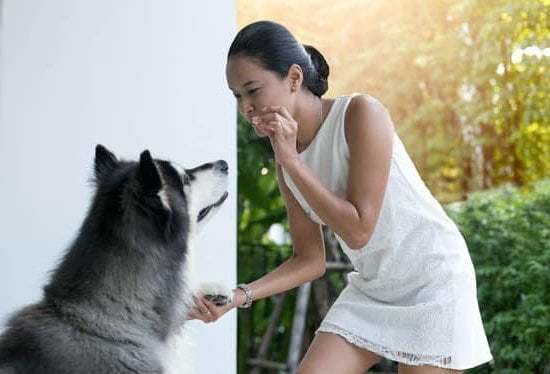For many families, the idea of bringing a four-legged companion into their home is an exciting prospect. When it comes to children, having a dog can offer numerous benefits that contribute to their physical, emotional, and social development.
In this article, we will dive into how to train dogs for children, exploring the positive impacts of dog ownership and providing practical tips on choosing the right breed, setting ground rules, basic obedience training, safety precautions, fostering a strong bond between dogs and children, dealing with bad habits and misbehavior, as well as additional resources for further training and support.
When it comes to kids and dogs, the relationship they share can be incredibly rewarding for both parties. Studies have shown that owning a dog can have a range of positive effects on children’s mental and physical health. From increased physical activity to lower stress levels and improved social skills, the benefits are indeed significant. We’ll explore these advantages in detail while also discussing research supporting the positive outcomes of having a furry friend at home.
But before diving into the nitty-gritty details of training dogs for children, we’ll start by addressing the crucial aspect of selecting the right breed. From considering size to temperament and energy levels, choosing a kid-friendly dog is essential in ensuring a harmonious relationship between your pet and your little ones.
We’ll highlight some of the best dog breeds known for their compatibility with children while also discussing important factors to keep in mind when making this decision.
Choosing the Right Dog Breed for Children
When it comes to choosing a dog for children, it is important to consider the breed that would best fit into your family dynamic. Some breeds are known to be more kid-friendly than others, so it’s crucial to take into account factors such as size, temperament, and energy levels.
For families with small children, it’s advisable to opt for a breed that is known for being gentle and patient. Breeds such as Labrador Retrievers, Golden Retrievers, and Beagles are often cited as good matches for families with kids due to their friendly nature and adaptability.
Another important consideration when choosing a dog breed for children is the size of the dog. Large or high-energy breeds may unintentionally knock over or overwhelm smaller children during playtime. Additionally, some smaller toy breeds may not have the patience for rough play or frequent handling by young children. Taking into account your family’s lifestyle and living space will help in determining the appropriate size of the dog that would best suit your household.
It’s also essential to consider any potential allergies that family members may have when selecting a dog breed. Breeds with minimal shedding such as Poodles or Bichon Frises are often recommended for families with allergy concerns.
Ultimately, consulting with a professional breeder or animal shelter can assist in finding a breed that aligns with your family’s needs and preferences. By taking time to carefully select a suitable dog breed based on temperament, size, and lifestyle compatibility, you can ensure a harmonious relationship between your new furry companion and your children.
Setting Ground Rules for Both Dogs and Children
When it comes to ensuring a harmonious relationship between dogs and children, it is essential to establish clear ground rules for both. This not only helps in creating a safe environment but also promotes respect and understanding between the two parties. Here are some key ground rules that should be set:
- Designate areas for the dog: It is important to establish areas where the dog can eat, sleep, and play without being disturbed. This ensures that the dog has their own space and can retreat when they need some alone time.
- Teach gentle handling: Children should be taught how to properly interact with the dog, including handling them gently and respecting their personal space. This can help prevent accidental injuries to both the dog and the child.
- Establish feeding routines: Create a schedule for feeding the dog and involve the children in this process. Teach them about portion control and the importance of not feeding the dog human food.
Emphasizing these ground rules early on can contribute to a positive dynamic between dogs and children, ensuring a safe and respectful relationship.
In addition to setting specific ground rules, it is important to educate both the children and the dogs on expected behaviors and interactions. Consistent reinforcement of these rules through positive training techniques will help create an environment where both parties can thrive. Setting boundaries also provides a sense of security for both the dog and the children, allowing them to coexist peacefully within a shared environment.
By establishing clear guidelines from the beginning, parents can facilitate a smooth integration of dogs into their household with children, ultimately leading to a happy and healthy cohabitation.
Basic Obedience Training for Dogs
Tips and Techniques
When training a dog to interact with children, basic obedience training is essential. Teaching a dog commands such as sit, stay, and come can help ensure that the dog listens to instructions from both adults and children.
When teaching these commands, it’s important to use positive reinforcement techniques such as treats and praise. Consistency is key in training, so make sure that all family members are on the same page when it comes to commands and expectations for the dog’s behavior around children.
The Importance of Consistent Training
Consistent training is crucial in ensuring that a dog behaves appropriately around children. Dogs require regular reinforcement of their training in order to maintain good behavior. It’s important for all family members to participate in the training process, especially if the goal is for the dog to interact safely with children. This not only helps the dog understand boundaries and expectations but also promotes a sense of responsibility among the children in caring for their pet.
Behavior Around Children
In addition to basic commands, it’s important to train a dog on how to behave around children. This may include not jumping on or knocking over small children, remaining calm during playtime, and responding well to handling by kids. By consistently practicing these behaviors with the dog, it can become accustomed to appropriate interactions with children and reduce the risk of accidents or misunderstandings between the pet and the kids.
Safety Precautions for Dogs and Children
Addressing Potential Safety Hazards
When it comes to the safety of both dogs and children, there are several potential hazards that should be addressed. One common concern is the risk of a child being knocked over by an enthusiastic dog, especially in the case of larger or more energetic breeds.
Additionally, small children may unintentionally hurt a dog by pulling on their ears or tail, which could result in the dog reacting defensively. It’s important to be aware of these potential dangers and take proactive measures to prevent them.
Tips for Safe Interaction
Teaching children how to interact safely with dogs is crucial for preventing accidents and fostering a positive relationship between the two. It’s important to educate children about appropriate ways to approach, pet, and play with a dog. This includes teaching them to always ask permission before approaching a new dog, avoiding sudden movements or loud noises that might startle the dog, and understanding when a dog needs space and should not be disturbed.
Safety Measures in the Home
In addition to teaching children how to interact safely with dogs, there are also safety measures that can be implemented within the home environment. For example, creating designated spaces where the dog can retreat if they need some alone time away from the children can help prevent stress or anxiety for both the dog and the kids.
It’s also important to keep potentially hazardous items such as food, medications, and small toys out of reach of both dogs and children to avoid accidental ingestion.
Overall, prioritizing safety precautions for both dogs and children is essential for creating a harmonious and secure environment for everyone involved. By addressing potential safety hazards, educating children on safe interaction with dogs, and implementing safety measures within the home, it is possible to minimize risks and facilitate a positive relationship between kids and their canine companions.
Encouraging a Strong Bond Between Dogs and Children
Fostering a strong bond between dogs and children is not only beneficial for the dog’s well-being but also for the overall development of the child. Some of the ways to encourage this bond include:
- Regular supervised playtime: Encourage supervised playtime between your dog and children. Simple activities such as fetching a ball or going for a walk together can help build trust and rapport between them.
- Involving children in dog care: Assign age-appropriate tasks to children, such as feeding the dog, grooming, or helping with training. This can create opportunities for bonding and teach children responsibility.
- Positive reinforcement: Instruct children on the importance of positive reinforcement when interacting with the dog. Encourage praise and rewards for good behavior to create a positive association between the two.
When kids are involved in their pet’s day-to-day routine, it can strengthen their relationship with their furry friend and thus allowing them to develop empathy, compassion, and companionship.
Creating a strong bond between dogs and children at an early age can have lasting benefits for both parties involved. Studies have shown that children who have strong bonds with their pets tend to have higher self-esteem, better social skills, and are more empathetic towards others. It also teaches them about responsibility and caring for another living being, which are important life lessons that will benefit them as they grow older.
In addition to building a healthy relationship with dogs, it is equally important to ensure that interactions are supervised, especially with younger children. Educating both kids and dogs on how to communicate effectively will lay down the foundation for a lifelong friendship between them.
Problem-Solving for Bad Habits and Misbehavior
Dogs, like children, can sometimes develop bad habits or exhibit misbehavior. It is important for dog owners, especially those with children, to address and correct these issues as they arise. Common issues that may arise when training dogs for children include excessive barking, jumping on people, and pulling on the leash. These behaviors can be disruptive at best and dangerous at worst, especially for young kids.
One way to address these bad habits is through positive reinforcement training. Using treats or rewards to encourage good behavior can be an effective method for correcting bad habits in dogs. For example, when a dog exhibits calm and controlled behavior rather than jumping on someone, they should be rewarded with praise or treats. This kind of conditioning can help the dog understand what behavior is acceptable and will help them learn to control their impulses.
Another strategy for addressing bad behavior in dogs is to redirect their attention. When a dog engages in undesirable behavior such as excessive barking or chewing on furniture, it can be helpful to redirect their attention to an appropriate activity. Providing them with a chew toy or engaging them in play can help shift their focus away from the problematic behavior.
Lastly, consistency is key when it comes to addressing and correcting bad habits in dogs. All family members involved in the care of the dog should be consistent with any rules or commands established during training. Even small deviations from the established training regimen can confuse the dog and undermine the progress made towards correcting bad habits.
| Common Bad Habits | Effective Solutions |
|---|---|
| Excessive Barking | Positive reinforcement training; Redirection of attention; Consistency in disciplining |
| Jumping on People | Positive reinforcement training; Using “sit” command as an alternative; Consistency among family members’ response |
| Pulling on the Leash | Use of no-pull harness; Positive reinforcement training; Consistent re-direction of attention |
Resources for Further Training and Support
In conclusion, training dogs for children can be a rewarding and beneficial experience for both the dog and the kids. The positive impact of having a dog on children’s physical and mental health cannot be overstated, with numerous studies and research supporting the benefits of dog ownership for kids. From increased physical activity to improved social skills and emotional well-being, the presence of a dog in a child’s life can make a meaningful difference.
When it comes to choosing the right dog breed for children, it is important to consider factors such as size, temperament, and energy levels. Some of the best kid-friendly breeds include Labrador Retrievers, Golden Retrievers, Beagles, and Bulldogs. Additionally, setting ground rules for both dogs and children is crucial in establishing boundaries and expectations for their interactions. Teaching children how to properly interact with the dog from a young age can help prevent potential safety hazards.
Basic obedience training for dogs is essential for ensuring their behavior around children remains consistent and safe. By teaching them commands such as sit, stay, and come, as well as addressing potential safety hazards and ways to prevent them, parents can help foster a strong bond between their pet and their kids.
However, it’s important to note that common issues may arise when training dogs for children, so being prepared with problem-solving strategies is key. Overall, ongoing education and training are essential for both the dog and the children in order to create a harmonious relationship between them.
Frequently Asked Questions
How Do I Train My Dog to Be Child Friendly?
Training your dog to be child-friendly involves socializing them at an early age with children and teaching them to be calm and gentle around kids. It’s important to use positive reinforcement techniques, such as treats and praise, to encourage good behavior around children.
Additionally, supervising interactions between your dog and children is crucial to ensure safety for both parties.
How to Train Your Dog Book for Children?
If you’re looking for a book on how to train your dog specifically targeted towards children, there are several options available that are written in a way that is easy for kids to understand. These books typically cover basic training techniques, responsible pet ownership, and the importance of forming a strong bond with their furry friend.
Look for books with engaging illustrations and step-by-step instructions to keep children interested in learning about training their canine companion.
How Do I Teach My Child to Play With a Dog?
Teaching a child to play with a dog should start with setting boundaries for both the child and the pet. It’s important for kids to learn how to approach the dog calmly and give them space when needed.
Show them how to interact safely by playing gentle games like fetch or teaching the dog tricks using positive reinforcement methods. Always supervise playtime between children and dogs to ensure a positive experience for both parties.

Welcome to the blog! I am a professional dog trainer and have been working with dogs for many years. In this blog, I will be discussing various topics related to dog training, including tips, tricks, and advice. I hope you find this information helpful and informative. Thanks for reading!





